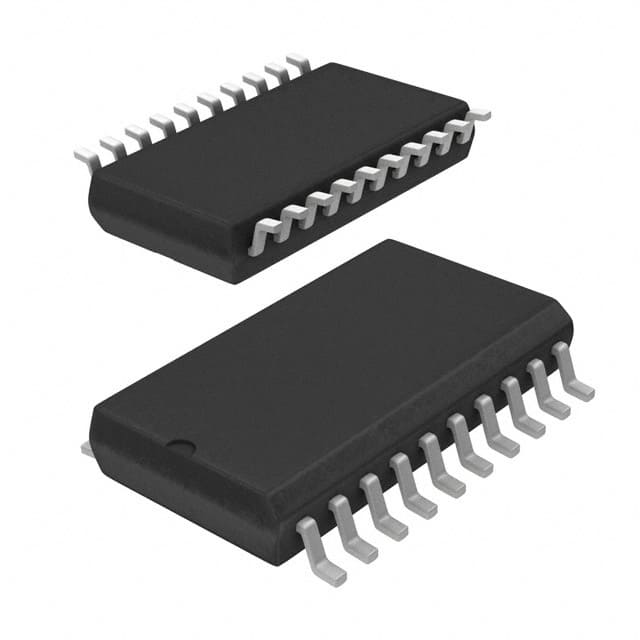Viz Specifikace pro podrobnosti o produktu.

SN74ALS621ADWRG4
Product Overview
- Category: Integrated Circuit
- Use: Logic Function
- Characteristics: High-speed, Low-power, TTL-Compatible
- Package: SOIC (Small Outline Integrated Circuit)
- Essence: 8-Bit Bus Transceiver with 3-State Outputs
- Packaging/Quantity: Tape and Reel, 2500 pieces per reel
Specifications
- Supply Voltage Range: 4.5V to 5.5V
- Input Voltage Range: 0V to VCC
- Output Voltage Range: 0V to VCC
- Operating Temperature Range: -40°C to +85°C
- Propagation Delay Time: 6ns (typical)
- Output Drive Capability: ±24mA
- Power Dissipation: 500mW (max)
Detailed Pin Configuration
The SN74ALS621ADWRG4 has a total of 20 pins. The pin configuration is as follows:
- A1 (Input)
- B1 (Input)
- G1 (Input)
- OE (Input)
- DIR (Input)
- B2 (Input)
- A2 (Input)
- G2 (Input)
- Y1 (Output)
- Y2 (Output)
- GND (Ground)
- NC (No Connection)
- NC (No Connection)
- VCC (Power Supply)
- NC (No Connection)
- NC (No Connection)
- Y3 (Output)
- Y4 (Output)
- G3 (Input)
- G4 (Input)
Functional Features
- Bidirectional Data Transfer: Allows data transmission in both directions.
- 3-State Outputs: Provides high impedance state when not enabled.
- TTL-Compatible Inputs: Can be directly interfaced with TTL logic devices.
- High-Speed Operation: Offers fast data transmission with low propagation delay.
Advantages and Disadvantages
Advantages: - High-speed operation enables efficient data transfer. - Low-power consumption for energy-efficient applications. - TTL compatibility allows easy integration with existing systems. - 3-state outputs provide flexibility in bus control.
Disadvantages: - Limited voltage range (4.5V to 5.5V) may restrict certain applications. - Propagation delay time of 6ns may not be suitable for ultra-high-speed operations. - Package size (SOIC) may require additional space compared to smaller packages.
Working Principles
The SN74ALS621ADWRG4 is an 8-bit bus transceiver that facilitates bidirectional data transfer between two buses. It operates based on the input signals received on the A1, B1, G1, OE, DIR, B2, A2, G2 pins. The direction of data flow is determined by the DIR pin. When DIR is high, data flows from A1 to B2, and when DIR is low, data flows from B1 to A2.
The OE (Output Enable) pin controls the output state. When OE is low, the outputs Y1 and Y2 are enabled, allowing data to be transmitted. Conversely, when OE is high, the outputs enter a high impedance state, effectively disconnecting them from the bus.
Detailed Application Field Plans
The SN74ALS621ADWRG4 finds application in various fields, including:
- Data Communication Systems: Enables bidirectional data transfer between different communication modules.
- Microprocessor Interfacing: Facilitates data exchange between microprocessors and peripheral devices.
- Industrial Automation: Supports data transmission in industrial control systems.
- Automotive Electronics: Used in automotive communication networks for data exchange.
- Test and Measurement Equipment: Allows data transfer between different test and measurement instruments.
Detailed and Complete Alternative Models
- SN74ALS623ADWRG4: 8-Bit Bus Transceiver with 3-State Outputs, similar to SN74ALS621ADWRG4 but with inverted DIR control.
- SN74ALS620ADWRG4: 8-Bit Bus Transceiver with 3-State Outputs, similar to SN74ALS621ADWRG4 but without G1 and G2 control.
These alternative models provide similar functionality with slight variations in features or pin configurations.
In conclusion, the SN74ALS621ADWRG4 is a high-speed, low-power 8-bit bus transceiver with 3-state outputs. It offers bidirectional data transfer, TTL compatibility, and flexibility in bus control. While it has certain limitations, such as voltage range and propagation delay, it finds applications in various fields including data communication systems, microprocessor interfacing, industrial automation, automotive electronics, and test and measurement equipment. Alternative models like SN74ALS623ADWRG4 and SN74ALS620ADWRG4 provide additional options based on specific requirements.
Seznam 10 běžných otázek a odpovědí souvisejících s aplikací SN74ALS621ADWRG4 v technických řešeních
Sure! Here are 10 common questions and answers related to the application of SN74ALS621ADWRG4 in technical solutions:
Q: What is SN74ALS621ADWRG4? A: SN74ALS621ADWRG4 is a specific type of integrated circuit (IC) commonly used in digital systems for data bus buffering and signal conditioning.
Q: What is the purpose of SN74ALS621ADWRG4? A: The main purpose of SN74ALS621ADWRG4 is to provide bidirectional buffering and voltage level translation between different sections of a digital system.
Q: What voltage levels does SN74ALS621ADWRG4 support? A: SN74ALS621ADWRG4 supports TTL (Transistor-Transistor Logic) voltage levels, which typically range from 0V to 5V.
Q: Can SN74ALS621ADWRG4 be used with other logic families like CMOS? A: Yes, SN74ALS621ADWRG4 can be used with other logic families like CMOS, as it provides voltage level translation between different logic families.
Q: How many data lines can SN74ALS621ADWRG4 handle? A: SN74ALS621ADWRG4 can handle up to 8 bidirectional data lines, making it suitable for applications requiring multiple data transfers.
Q: Does SN74ALS621ADWRG4 have any built-in protection features? A: Yes, SN74ALS621ADWRG4 has built-in ESD (Electrostatic Discharge) protection diodes to safeguard against electrostatic damage during handling.
Q: What is the maximum operating frequency of SN74ALS621ADWRG4? A: SN74ALS621ADWRG4 can operate at frequencies up to 25 MHz, making it suitable for many digital applications.
Q: Can SN74ALS621ADWRG4 be used in both commercial and industrial environments? A: Yes, SN74ALS621ADWRG4 is designed to operate reliably in both commercial and industrial temperature ranges.
Q: Is SN74ALS621ADWRG4 available in different package options? A: Yes, SN74ALS621ADWRG4 is available in various package options, including SOIC (Small Outline Integrated Circuit) and TSSOP (Thin Shrink Small Outline Package).
Q: Where can I find more information about the application of SN74ALS621ADWRG4? A: You can refer to the datasheet provided by the manufacturer or visit their official website for detailed information on the application of SN74ALS621ADWRG4.
Please note that the answers provided here are general and may vary depending on specific requirements and use cases. It's always recommended to consult the datasheet and technical documentation for accurate information.

